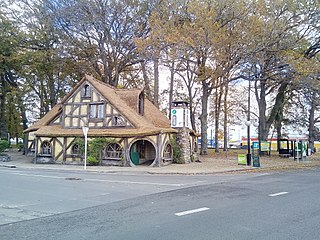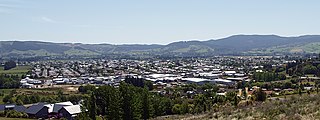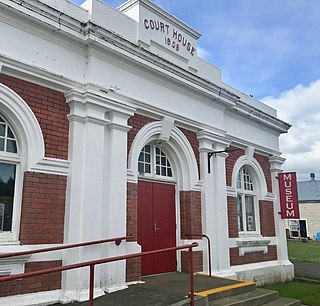Related Research Articles

The Women's Land Army (WLA) was a British civilian organisation created in 1917 during World War I so women could work in agriculture. It was revived from the disbanded World War One organisation in 1939 so that it could again organise women to replace workers called up to the military. Women who worked for the WLA were commonly known as Land Girls. In effect the Land Army operated to place women with farms that needed workers, the farmers being their employers. They picked crops and did all the jobs that the men had done. Notable members include Joan Quennell, later a Member of Parliament.

The Waikato is a local government region of the upper North Island of New Zealand. It covers the Waikato District, Waipa District, Matamata-Piako District, South Waikato District and Hamilton City, as well as Hauraki, Coromandel Peninsula, the northern King Country, much of the Taupō District, and parts of Rotorua District. It is governed by the Waikato Regional Council.

Matamata is a town in Waikato, New Zealand. It is located near the base of the Kaimai Ranges, and is a thriving farming area known for Thoroughbred horse breeding and training pursuits. It is part of the Matamata-Piako District, which takes in the surrounding rural areas, as well as Morrinsville and Te Aroha. State Highway 27 and the Kinleith Branch railway run through the town. The town has a population of 8,570 as of June 2021.

Mosgiel is an urban satellite of Dunedin in Otago, New Zealand, fifteen kilometres west of the city's centre. Since the re-organisation of New Zealand local government in 1989 it has been inside the Dunedin City Council area. Mosgiel has a population of approximately 14,700 as of June 2021. The town celebrates its location, calling itself "The pearl of the plain". Its low-lying nature does pose problems, making it prone to flooding after heavy rains. Mosgiel takes its name from Mossgiel Farm, Ayrshire, the farm of the poet Robert Burns, the uncle of the co-founder in 1848 of the Otago settlement, the Reverend Thomas Burns.

The Royal New Zealand Infantry Regiment is the parent administrative regiment and corps of regular and reserve infantry battalions in the New Zealand Army. It was originally formed in 1947 with a singular Regular regiment and multiple reserve regiments. Over time, the regiments were turned into battalions, the reserve units amalgamated and more regular units raised and disbanded. Currently, the Regiment currently consists of two regular and three reserve battalions. Throughout its existence, units raised in this regiment have served and deployed on operations in Malaya, Vietnam, Borneo and various United Nations peacekeeping operations.

The Woman's Land Army of America (WLAA), later the Woman's Land Army (WLA), was a civilian organization created during the First and Second World Wars to work in agriculture replacing men called up to the military. Women who worked for the WLAA were sometimes known as farmerettes. The WLAA was modeled on the British Women's Land Army.

Otautau is a small farming, forestry and milling town located inland on the western edge of the Southland Plains of New Zealand on the banks of the Aparima River. Otautau is located approximately 40 kilometres (25 mi) north west of Invercargill. The average elevation of Otautau is 60 meters.
Mary Sutherland was a notable New Zealand forester and botanist. She was born in London, England in 1893.

The South African Native Labour Corps (SANLC) was a force of workers formed in 1916 in response to a British request for workers at French ports. About 25,000 South Africans joined the Corps. The SANLC was utilized in various menial noncombat tasks. The SANLC was disbanded by the South African government in January 1918.

Australian women during World War II played a larger role than they had during World War I.
Rose Moore Hinchey was a New Zealand civilian and military nurse.

Rangiaowhia was, for over 20 years, a thriving village on a ridge between two streams in the Waikato region, about 4 km (2.5 mi) east of Te Awamutu. From 1841 it was the site of a very productive Māori mission station until the Invasion of the Waikato in 1864. The station served Ngati Hinetu and Ngati Apakura. Only a church remains from those days, the second oldest Waikato building.
The 1949 New Year Honours in New Zealand were appointments by King George VI on the advice of the New Zealand government to various orders and honours to reward and highlight good works by New Zealanders, and to celebrate the passing of 1948 and the beginning of 1949. They were announced on 1 January 1949.
The 1950 King's Birthday Honours in New Zealand, celebrating the official birthday of King George VI, were appointments made by the King on the advice of the New Zealand government to various orders and honours to reward and highlight good works by New Zealanders. They were announced on 8 June 1950.
The 1956 New Year Honours in New Zealand were appointments by Elizabeth II on the advice of the New Zealand government to various orders and honours to reward and highlight good works by New Zealanders. The awards celebrated the passing of 1955 and the beginning of 1956, and were announced on 2 January 1956.

The Women's Land Army (WLA) was a British civilian organisation. It was created in 1917 by the Board of Agriculture during World War I to encourage women to work in agriculture, replacing men called up to the military. Women who worked for the WLA were commonly known as Land Girls. In effect the Land Army operated to place women with farms that needed workers, the farmers being their employers. They picked crops and did all the jobs that the men would do. Notable members included the archaeologist Lily Chitty and the botanist Ethel Thomas. It was disbanded in 1919 but revived in June 1939 under the same name.
Kiwitahi is a rural community in the Matamata-Piako District and Waikato region of New Zealand's North Island, located directly south of Morrinsville.
The 1983 Queen's Birthday Honours in New Zealand, celebrating the official birthday of Elizabeth II, were appointments made by the Queen in her right as Queen of New Zealand, on the advice of the New Zealand government, to various orders and honours to reward and highlight good works by New Zealanders. They were announced on 11 June 1983.

Louisa Wilkins OBE, also known as Mrs Roland Wilkins was a British writer and agricultural administrator. She was involved in the creation and recruitment for the Women's Land Army during World War One. She was an enthusiast for small holdings and after the war she inspired the creation of a small holding co-operative for women who had entered agriculture during the war.
The forerunner of the Working For Gardeners Association was created in 1899. It has had various names including the Women's Farm and Garden Society (WFGS) and the Women's Farm and Garden Union (WFGU). Its original objective was to improve the employment opportunities for women working on the land. During the First World War, it created the Women's National Land Service Corps (WNLSC) in 1916 and recruited 2,000 volunteers. At the WNLSC's suggestion, the government created the Women's Land Army. In 1920, the WFGU was concerned that after the war, women were not being offered the help that men were. It created a cooperative set of small holdings for women in Surrey. During the Second World War, it organised training. The charity organised training courses for both women and men in 2020 under its new working name of the Working For Gardeners Association.
References
- 1 2 3 4 "Report Of The National Service Department On Activities Under The National Service Emergency Regulations 1940 And The Industrial Man-Power Emergency Regulations 1944". Appendix to the Journals of the House of Representatives. Session I, H-11A: 63–64. 1946 – via Paperspast.
- ↑ McKenzie-McLean, Jo (25 April 2018). "Land Girls, New Zealand's World War II unsung heroes". Southland Times. Retrieved 7 March 2020– via Stuff.co.nz.
- ↑ "Women's Land Army: Work begins at Matamata". New Zealand Herald. 14 November 1940. Retrieved 21 December 2021– via Paperspast.
- ↑ "Land Corps". Evening Post. 8 November 1941. Retrieved 21 December 2021– via Paperspast.
- ↑ "The Land Girls: In a Man's World, 1939–46 by Dianne Bardsley". Otago University Press. Retrieved 7 March 2020.
- ↑ "Solving the Farm Labour Problem". New Zealand Journal of Agriculture. 67 (4): 253. 15 October 1943 – via Paperspast.
- ↑ White, Tina (11 May 2019). "Remembering the land girls of World War II". Manawatu Standard. Retrieved 7 March 2020– via Stuff.co.nz.